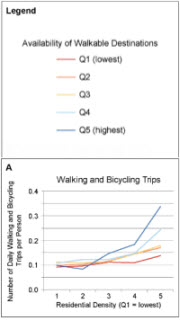 Researchers at St. Michael's Hospital in Toronto have published an article in the peer-reviewed PLOS ONE journal describing research to measure what physical features associated with walkability produce the greatest results in the number of walk trips. The study focuses on the interactions between residential density and the availability of walkable destinations and transportation, obesity, and diabetes, depicting the interactions graphically and examining them statistically using general linear modeling.
Researchers at St. Michael's Hospital in Toronto have published an article in the peer-reviewed PLOS ONE journal describing research to measure what physical features associated with walkability produce the greatest results in the number of walk trips. The study focuses on the interactions between residential density and the availability of walkable destinations and transportation, obesity, and diabetes, depicting the interactions graphically and examining them statistically using general linear modeling.
The study finds that individuals living in "more walkable areas" were more than twice as likely to walk, bicycle, or use public transit and were significantly less likely to drive or own a vehicle compared with those living in less walkable areas. Individuals in less walkable areas were up to one-third more likely to be obese or to have diabetes. More specifically, while residential density and the availability of walkable destinations were each, individually, significantly associated with transportation and health outcomes, the combination of high levels of both measures was associated with the highest levels of
- Walking or bicycling
- Public transit use
- The lowest levels of automobile trips
- Lowest diabetes prevalence.
The authors conclude that both residential density and the availability of walkable destinations are good measures of urban walkability and can be recommended for use by policy-makers, planners, and public health officials.